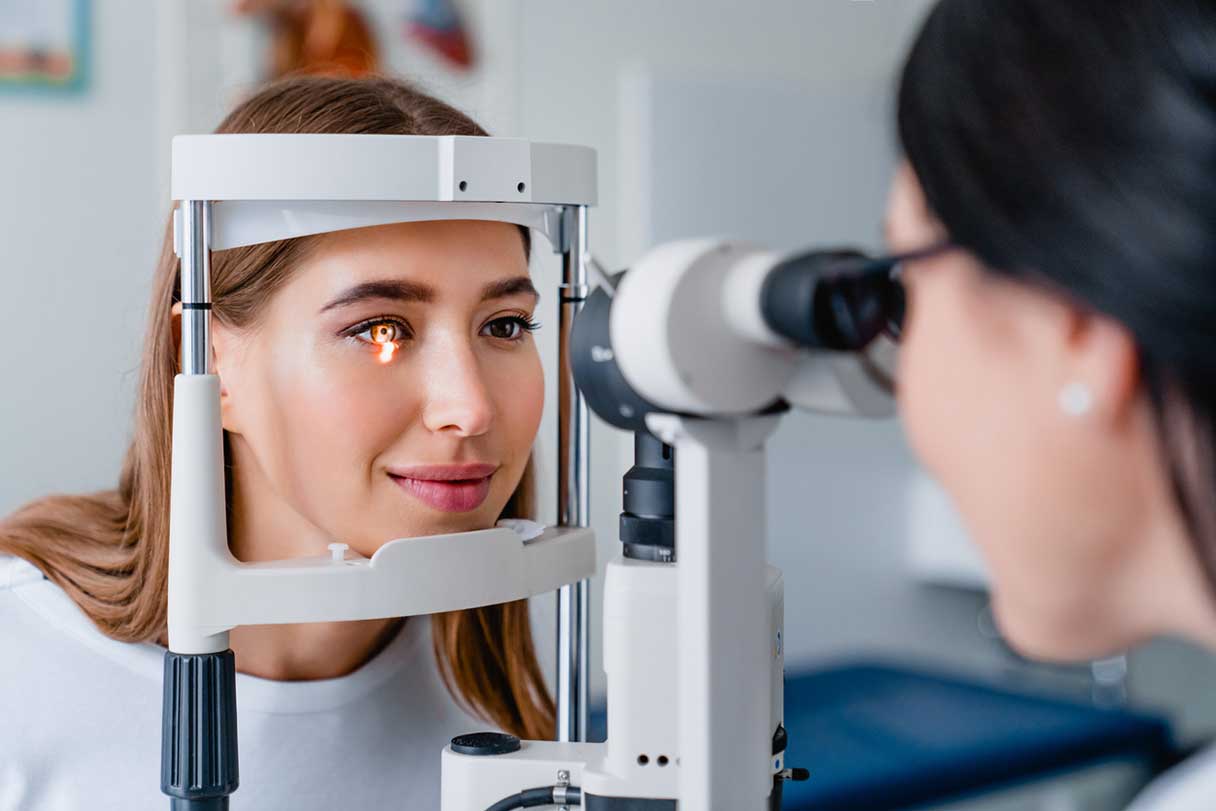Uveitis causes redness and irritation of the eyes, which leads to loss of sight in around 30,000 Americans each year.1 It affects people of all ages, including children, but is more common in women and those between the ages of 40 and 60.1
This painful condition has many triggers, and your ophthalmologist can determine the right treatment for your uveitis based on its cause. Here, we explore what health conditions can cause uveitis, what effects it can lead to and how much it costs to treat it.
What Is Uveitis?
Uveitis refers to a group of conditions that cause redness, irritation and pain in the uvea, located in the middle section of the eye.1 It can affect one or both of your eyes.1
The uvea supplies blood to the retina and is comprised of the:1
- Iris, the colored part of the eye
- Choroid, a membrane containing blood vessels that connects the retina to the sclera3
- Ciliary body, which connects the iris and choroid, providing nutrients to your eye and helping the eye focus3
Uveitis can also affect the eye's:1
- Retina, the inner layer of the eye that processes images and allows you to see
- Sclera, the white part of your eye
Uveitis vs. conjunctivitis
Although these terms may sound similar, they are two very different conditions that both affect the eye.
- Uveitis is an inflammatory condition that affects the inner part of the eye,3 including the uvea, retina or sclera.1 It has a variety of causes, including autoimmune conditions and infections.3 Injuries to the eye can also be a cause.1
- Conjunctivitis, also known as pink eye, causes inflammation of the outer part of the eye known as the conjunctiva, which is the clear tissue that covers the white part of the eye and lines the inside of your eyelid. It is usually triggered by a viral or bacterial infection of the eye, allergies or a chemical irritant. If caused by a virus or bacteria, it is highly contagious and easily spread from person to person.2
Does uveitis affect pets and humans?
Yes, uveitis can affect both people and pets, including dogs4 and cats.5 In fact, it has many of the same forms and causes in pets as it does in people, plus many of the treatments are the same and/or modified for our four-legged friends, such as oral and topical medications.
If you see that your cat or dog has redness and irritation in their eyes, it's time for them to visit the veterinarian for treatment.
Types of Uveitis
There are four types of uveitis: anterior, intermediate, posterior and panuveitis.1
- Anterior uveitis is the most common type of uveitis that leads to inflammation in the front of the eye.1 It's also known as iritis or iridocyclitis.6
- Intermediate uveitis is a condition most common in young adults that leads to inflammation in the middle of the eye.1 It's also referred to as cyclitis or vitritis because it affects the vitreous, a fluid-filled space within the eye itself,1 and the ciliary body.3
- Posterior uveitis is the least common form of uveitis and affects the inner part of the eye, including the retina, optic nerve and choroid.1 It's also known as choroiditis or chorioretinitis.1
- Panuveitis affects all three layers of the eye. It's the most severe form and can lead to vision loss.1
Note that each type of uveitis may also be classified as:7
- Acute, which clears up within three months
- Recurrent, which clears up but reoccurs every few months
- Chronic, which returns within three months after you stop treatment
What Causes Uveitis?
Uveitis has many possible causes, and one-third of all cases have no known cause.1 Causes of uveitis can include:8
- Smoking
- Viruses such as shingles, herpes simplex, viral retinitis1 or chicken pox1
- AIDS3
- Syphilis
- Lyme disease
- Parasites, including toxoplasmosis
- Behcet's disease3
- Inflammatory bowel disease (IBD), ulcerative colitis3 and other gastrointestinal problems1
- Rheumatoid arthritis
- Lupus
- An injury to the eye
- Tuberculosis1
- Eye surgery1
- Bacterial or fungal infections of the eye1
- Multiple sclerosis (MS)3
- Sarcoidosis3
- Ankylosing spondylitis (AS)3
- Cancers that affect the eye, including lymphoma3
- Psoriasis3
Symptoms of Uveitis
Uveitis can come on suddenly and sometimes has no symptoms at all.9 It can affect one or both of the eyes.9 Those with uveitis may suffer from:9
- Redness in the eye
- Pressure and pain in the eye1
- Sensitivity to light
- Blurry vision
- Vision loss1
- Loss of peripheral vision7
- Floaters, which are dark floating spots in your vision
- Headaches10
How Is Uveitis Diagnosed?
For those without any symptoms, uveitis is sometimes found during a regular annual eye exam with your ophthalmologist.9 To properly diagnose uveitis, your ophthalmologist will:1
- Measure the pressure within your eye using tonometry
- Test your eyesight by having you read an eye chart to see if you are experiencing any vision loss
- Use a special microscope called a slit lamp to examine the inside of your eye
- Dilate your eyes to widen your pupils and look inside your eyes with a special lens, a procedure known as funduscopy9
- Perform a visual field test to see if you have any peripheral vision loss
- Ask you about your family history — those with family members who have had uveitis may be more prone to developing it10
- Recommend blood work, imaging and other lab testing to check for an infection or an autoimmune condition that could be causing your uveitis10
- Take a picture of the inside of your eye, including the retina9
- Analyze the vitreous fluid of the eye9
- Perform more detailed examination of the eye using special imaging such as optical coherence tomography (OCT), fluorescein angiography or indocyanine green angiography9
Uveitis Treatments
Depending on the cause and severity of your uveitis, there are several treatments available to give you some relief. Your doctor will recommend the best one for you. Some common treatments for uveitis include:
- Steroids
- Immunosuppressive therapy
- Antibacterial or antiviral drugs
- Pain-relieving medications
- Surgery
- At-home care
Steroids
One of the most common treatments for uveitis are steroid-based to reduce the inflammation caused by this condition.7 If your doctor rules out an infection as the cause of your uveitis, they may opt to give you:11
- Steroid eye drops such as Durezol® (difluprednate ophthalmic emulsion) or prednisolone to treat both anterior and intermediate uveitis. Prednisolone acetate eye drops average around $23 for a 5-milliliter bottle, while Durezol eye drops cost around $49 for a bottle of the same size.12
- Oral steroids that reduce inflammation systemically if the drops aren't effective at treating the uveitis. They cost around $5 for 30 pills, each 5 milligrams.12
- Steroid injections directly into the eye or given over time through a surgically placed implant to treat posterior uveitis or panuveitis. An Ozurdex® (dexamethasone ophthalmic) implant costs around $1,455,13 and a 1-milliliter vial of Triesence® (triamcinolone ophthalmic) costs around $179.14
Note that oral steroids are a short-term solution and not suitable for long-term use because they can lead to a number of health problems, including diabetes, glaucoma, cataracts and osteoporosis.15
Immunosuppressive therapy
For those dealing with an autoimmune condition as the cause of their uveitis or those whose uveitis hasn't responded to steroids, your doctor may recommend an immunosuppressive drug.1 This is especially true for those with chronic uveitis11 or uveitis that is threatening your eyesight.1
These drugs help suppress your immune system to prevent it from attacking your own healthy cells.15 They include:11
- An antimetabolite such as methotrexate, which may take from three to six months to work and can cause nausea, vomiting, fatigue and in some cases, liver toxicity. These potential side effects typically decrease over time.
- A biologic such as Humira® (adalimumab). If antimetabolites aren't controlling your uveitis, a biologic such as adalimumab might help, which is given via self-injection every other week. Other biologics like Remicade® (infliximab) are given via infusion at a doctor's office. Biologics require regular blood tests to monitor your white blood cell count and liver and kidney function. They can also lead to certain types of cancers.15
- In some cases, your doctor may prescribe a combination of both antimetabolites and biologics to keep your uveitis under control. They may also recommend a short-term dose of steroids to give these medications a chance to start working.
- Methotrexate costs around $12 to $30 for a quantity of 24 pills, each 2.5 milligrams.16
- Humira costs around $6,758 to $7,651 per carton of two pens.17
- A single infusion of Remicade costs between $1,300 and $2,500.18
Antibacterial or antiviral drugs
If your ophthalmologist finds that a bacteria or viral infection is responsible for your uveitis, they may prescribe an antibacterial or antiviral drug to treat it.11
- Neomycin/polymyxin b/hydrocortisone antibacterial and anti-inflammatory eye drops cost around $31 for a 10-milliliter bottle.12
- Acyclovir, an oral antiviral used to treat uveitis,19 costs on average $17.80 for 30 tablets, each 400 milligrams.20
Pain-relieving medications
Depending on how severe your uveitis is, your doctor may prescribe pain-relieving mydriatic and cycloplegic eye drops.21
- These types of drops relax the muscles of your eyes and dilate your pupils to provide some measure of pain relief.21 They also help with sensitivity to light.21
- Tropicamide drops cost on average between $10 and $25 for a 15-milliliter bottle.22
- Cyclopentolate drops cost on average between $10 and $20 for a 2-milliliter bottle.23
Surgery
In some cases, your doctor may recommend surgery to treat your uveitis if other options haven't helped.15
- A procedure known as a vitrectomy removes the vitreous gel from inside your eye and puts air, gas or fluid in its place.15 Eventually, your eye will fill with new vitreous fluid.15
- This pricey surgery comes with an average cost of $14,550.24
At-home care
In addition to seeing your ophthalmologist, there are a few steps you can take at home to help treat your uveitis, including:
- Wear sunglasses15 that offer 100% protection against UVA and UVB rays that could further irritate your eyes, especially if you are suffering from light sensitivity. Look for a pair with a UV400 rating on the label.25
- Top off your look with a hat to further shield your eyes from the sun.25
- Take vitamin E and vitamin D to help your eye health and your immune system.26
- Place a warm towel over your eyes to help ease inflammation and pain.15
- Clean away any discharge from your eyes using sterilized water and cotton pads.26
- Take ibuprofen to treat the discomfort of uveitis.15
What if I don't treat uveitis?
If left untreated, uveitis can lead to a variety of negative outcomes, including:1
- Cataracts
- Glaucoma
- Retinal damage or detachment
- Permanent vision loss
- Damage to the vitreous of the eye
Is uveitis treatment covered by health insurance?
Uveitis is a condition that most health insurance will cover — both diagnosis and treatment. Health insurance will also cover treatment for most underlying health conditions that can lead to uveitis.27
How to Prevent Uveitis
Because there are so many possible causes for uveitis, there's no way to completely prevent it. However, there are some steps you can take to maintain good eye health. These include:1
- Quit smoking, because it can be a trigger for uveitis.
- Get annual eye exams with your eye care provider.28 Your provider can find signs of uveitis even if you don't have any symptoms.9
- Treat health conditions that may cause uveitis.
- Get regular exercise and eat a healthy diet.28
- Wear sunglasses that protect your eyes from both UVA and UVB rays.28
- Use protective eyewear while playing sports or working in construction to prevent injuries to your eyes.28
CareCredit Credit Card Financing for Uveitis Treatment
Whether you’re paying for eye surgery or getting an eye exam, the CareCredit credit card can help you pay for care where your insurance leaves off.* Use our Acceptance Locator to find a vision specialist near you that accepts CareCredit. Continue your wellness journey by downloading the CareCredit Mobile App to manage your account, find a provider on the go and easily access the Well U blog for more great articles, podcasts and videos.
In addition to vision care, you can also use your CareCredit credit card for dentistry, cosmetic, pet care, hearing, health systems, dermatology, pharmacy purchases, spa treatments and so much more within the CareCredit network. How will you invest in your health and wellness next?
Author Bio
Susan Paretts is a freelance writer with 19 years of experience covering health and wellness, pet care and more. Her work has been published by the American Kennel Club, Bayer Animal Health, Elanco, LIVESTRONG.com, The San Francisco Chronicle, Chewy and more.







